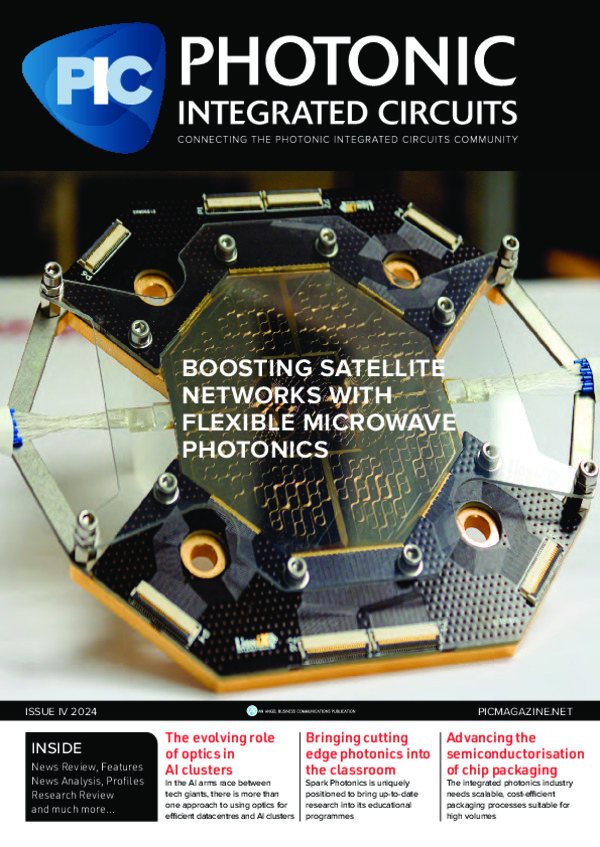
PIC progress in the spotlight at 50th ECOC

Research into integrated photonics had barely begun when the first ECOC took place in 1975, but this year PICs were front and centre throughout the conference and exhibition.
by Laura Hiscott, Editor PIC Magazine
In today’s era of rapid technological progress, it is always possible to look back and be awestruck by the huge strides that have been made in a short time. But milestone anniversaries often serve as useful prompts for this kind of reflection, and this opportunity was not lost at the 50th edition of the European Conference on Optical Communication (ECOC), which took place in Frankfurt this September.
It was a record-setting event in many ways, with over 1800 conference participants attending from more than 30 countries – more participants than at any previous ECOC. There were also over 500 talks and more than 2000 pages of conference proceedings, compared with just 74 papers presented at the first event in London in 1975. The goal in focus at that first ECOC was Mb/s transmission speeds, but the industry is now setting its sights on Pb/s, a staggering nine orders of magnitude higher.
But the progress is perhaps even starker for the PIC industry specifically, considering that photonic integration was not even on the agenda in London in 1975. Indeed, research into the field had barely begun at that time, but it appeared as a firm fixture in Frankfurt this year.
Meint Smit, widely considered an early pioneer of PICs, opened the special symposium on 50 years of ECOC with an overview of the progress made in indium phosphide PIC technologies. Meanwhile, JePPIX, the Joint European Platform for Photonic Integration of Components and Circuits, which Smit founded, co-hosted an anniversary of its own; together with ePIXfab, they held the 15th European Photonic Integration Forum (EPIF).
AI was, of course, a running theme throughout both the conference and the exhibition, with numerous companies demonstrating innovations to boost transmission speeds for the data-hungry new world. In acknowledgement of this major topic, the event organisers had AI generate a song to celebrate the 50th ECOC – something that the attendees of the very first conference back in 1975 might not have been able to imagine.
During one of the plenary sessions, Joyce Poon, head of photonics architecture at Lightmatter, spoke about the company’s interconnect product Passage, which incorporates 3D co-packaged optics to enable higher-bandwidth communications between chips – essential for AI applications.
But Poon also flipped the script, asking not only what photonics can do for AI, but also what AI can do to advance photonics. To this end, Poon and her team are currently developing an AI-based photonics design assistant called PhIDO (Photonics Intelligent Design and Optimisation). The team hope to progress towards a tool that can interact with designers and speed up design optimisation, eventually generating first-time-right layouts and lowering the costs and barrier to entry in photonics. Closing her talk, Poon spoke about her optimism that we might see the emergence of an AI “super-engineer” within a decade, that could significantly accelerate progress in all branches of photonics research.
Attendees interested in PICs were also spoilt for choice when it came to the main schedule of presentations, with sessions dedicated to integrated photonics taking place every day of the conference. Klaus Jöns of Paderborn University opened a session on light sources for quantum communication with an overview of the “zoo” of different ways of achieving quantum light generation.
He first ran through several key figures of merit for these essential components, from the ability to generate background-free indistinguishable photons to the need for high brightness and tuneability to the desired wavelength. Jöns then described various sources, including 2D materials, colour centres, single atoms and ions, and spontaneous parametric down conversion. After summarising how well these techniques fit the essential criteria, he showed that quantum dots are a particularly promising light source, but with the caveat that they have benefitted from more years of research than 2D materials, for instance.
It is not only quantum applications that have a wide range of options for the underlying technologies. In a session on integrated sensing and communications, Antonella Bogoni from the Sant’Anna School of Advanced Studies in Pisa spoke about her group’s aim of developing miniaturised radar systems based on integrated microwave photonics.
She compared several different material platforms that could be used for this task, showing that indium phosphide heterogeneously integrated with lithium niobate on insulator looks like the most promising option in terms of conversion performance and RF signal distribution. Although the technology is in its early stages of development, Bogoni emphasised that there is a lot of interest in the benefits that microwave photonics can bring to radar, so this will hopefully drive rapid progress in the area.
While ECOC is, of course, all about communications, these talks and others showcased the rich variety of other applications that PICs are now branching into. In another plenary session, Roel Baets, a PIC pioneer who previously worked at Ghent University and imec, highlighted that, at imec alone, PICs are being developed for everything from LiDAR to biosensing to optical coherence tomography. However, Baets also pointed out that there is a long way to go, noting that, when looking for non-transceiver PIC products, he and his colleagues were only able to find six that have so far made it to market.
In this vein, Baets set out his vision for “silicon photonics industry 4.0,” highlighting the need to break down supply chain barriers for start-ups and scale-ups, despite diversifying technologies and markets. Some of the key ingredients he recommended to move in this direction included a decentralised open-access foundry and supply chain model, and standardised modules that can be reused for different applications. Baets concluded his talk with a call to mobilise resources towards making the diverse and exciting potential of PICs a reality.
This message echoed throughout the conference. With the ECOC lanyards featuring the NOKIA logo – a reminder of the connectivity giant’s recent acquisition of Infinera – it appears that PICs are well established, having made themselves indispensable in communications. But there are also plenty of opportunities for growth across a broader range of markets. This is an exciting phase for any industry, but perhaps also an uncertain one. To really take off, these technologies will need much more investment and development. But the potential future fruits of those efforts, as envisioned and laid out by today’s innovators in the field, will surely be worth it.



































